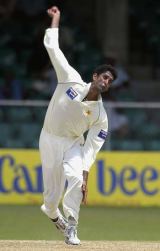Shabbir banned for one year
Shabbir Ahmed has become the first bowler to be banned from international cricket for 12 months due a suspect action
Cricinfo staff
19-Dec-2005
|
|

|
He was first reported and suspended earlier this year but returned to action following remedial work on his action and a full bio-mechanical analysis that demonstrated that he had made the necessary adjustments to his bowling style. However, having been reported and assessed as bowling illegally for a second time within two years of the first period of suspension, Shabbir has received a mandatory one-year ban.
His team-mate, Shoaib Malik, was reported for the first time under the revised ICC regulations in the same match against England and travelled to the University of Western Australia to undergo independent analysis.
Through this testing he was able to demonstrate that the bowling action he used in the match and in the laboratory falls within the ICC regulations. His doosra was not tested as he says he no longer bowls this in matches. He has been advised that, provided he employs an action consistent with that used in the laboratory, he can continue to bowl in international cricket.
Professor Bruce Elliott, who lead the investigation into both bowlers says that Shabbir is likely to pass the permitted 15 degree limit. "It could therefore be concluded, given Shabbir's current level of maximum elbow flexion, that he probably bowls some deliveries in each innings that are above the acceptable 15-degree tolerance limit."
The ICC chief executive, Malcolm Speed, said that Shabbir's suspension was an appropriate step. "While it is regrettable that any player is suspended from international cricket, the suspension is an appropriate step on this occasion. It is clear that Shabbir has the capacity to bowl with a legal action but it would seem that on occasion he has the tendency to revert to old habits.
"Having had the opportunity to remedy this flaw but not being able to do so consistently, a suspension for 12 months provides him with the opportunity to permanently address the concerns that have been identified. At the same time, it indicates the ICC's seriousness in tackling this issue."
The current process contrasts with previous eras where, once a bowler was called for throwing or was suspected of having an illegal action, there was often no way back to international cricket. Speed added: "I hope that Shabbir will be able to use his time out of the game at international level to get the consistency needed in his action to ensure a successful return to the game."
The latest assessment of Shabbir's action was based on examination of footage from the Multan Test in comparison with a University of Western Australia laboratory assessment which he underwent in September 2005. Shabbir can appeal to the ICC's specialist bowling review group to seek to overturn the ban. He must lodge a request for such a hearing within 14 days of the PCB's receipt of the assessment of his action.